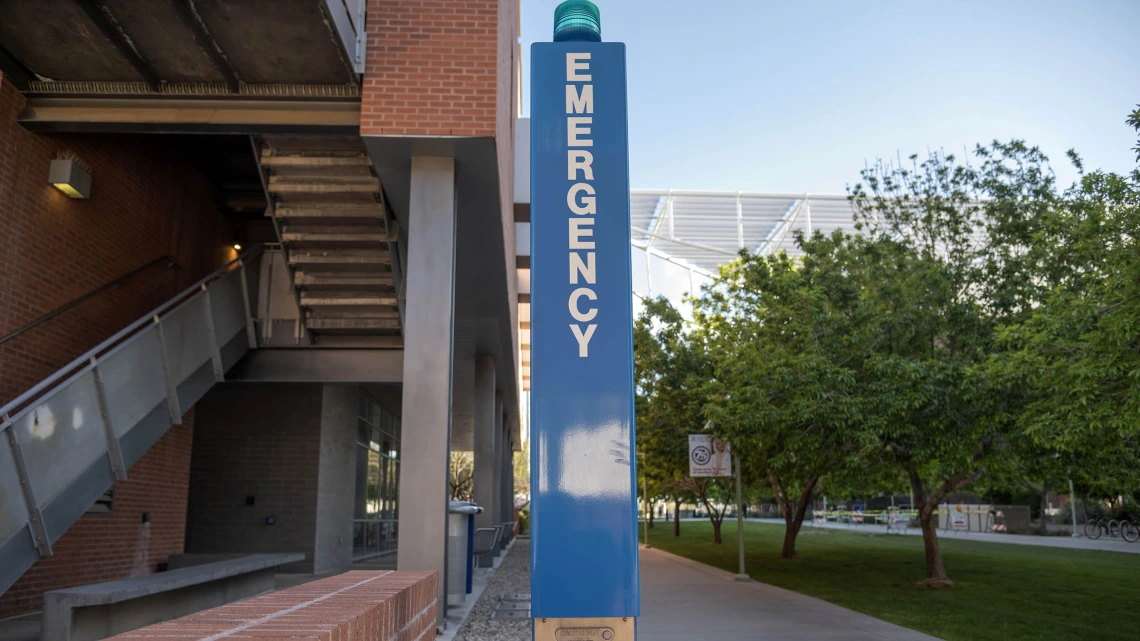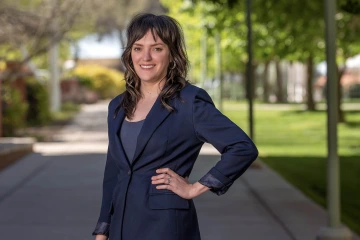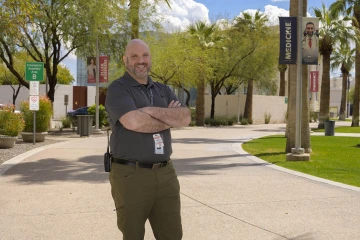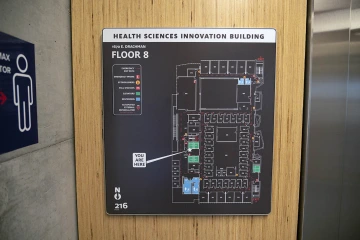Staying safe at UArizona Health Sciences
University specialists have created a full suite of information to help keep the Tucson, Phoenix and Gilbert campuses safe in the event of an emergency.

911 emergency blue light phones located on University of Arizona campuses provide direct access to emergency assistance.
Fire alarms go off in the Health Sciences Innovation Building in Tucson – what should you do? A staff member sees chemicals spilled in the Biomedical Sciences Partnership Building in Phoenix – does the university need to be notified? Someone in a nursing simulation suite in the University Building in Gilbert has a medical emergency – should an employee call university police or 911?
If a threat or disaster happens at the University of Arizona Health Sciences, employees should feel confident knowing how to respond, and thanks to a plethora of resources, they can. The university has teams who work together to help prepare faculty, staff and students for emergency situations, monitor and oversee research laboratory safety, manage risk, assess and manage threats and respond to critical incidents on campus.
Be informed before an emergency happens

Maura Ross, senior program coordinator, UArizona Health Sciences Planning and Facilities.
“Everyone needs to be aware of their surroundings and think ahead of time what they would do in the event of an emergency,” said Maura Ross, senior program coordinator for planning and facilities at the University of Arizona Health Sciences. “Know where your exit stairwells are. Think about places you could hide in your space in the unfortunate event that you need to. The main thing is to try to be prepared.”
The UArizona Critical Incident Response Team’s website is a practical place to start and a good site to bookmark. The website has information on what to do in the event of a variety of disasters ranging from a hostage situation, an armed individual or active shooter situation, bomb threat, suspicious package or letter found, fire or explosions, earthquake, hazardous material spills and more. The instructions apply to all UArizona campuses.
“It is important for anyone with a disability to know where accessible exits are, the best routes to take and any areas of safe refuge,” said Eric Bell, a physical access consultant with the Disability Resources Center. “Being prepared for an emergency is having a plan and being familiar with your building and your surroundings.”
“The Disability Resource Center provides regular input into our evacuation plans for persons with disabilities,” added Lane Spalla, project manager and emergency management coordinator with the UArizona Office of Emergency Management.
Know where help is located

Eric Bell, physical access consultant, Disability Resources Center.
If an emergency is in progress, the quickest way to obtain help is to call 911. Dialing 911 from a university landline or wired Zoom phone will connect to the University of Arizona Police Department. Calls from a cell phone, including Zoom calls placed on a cell phone, are routed to the local emergency telephone system. Tucson callers who identify their location as the University of Arizona are immediately connected to the university’s police department. Local police will be dispatched in Phoenix and Gilbert.
The campus map shows the location of all 911 emergency blue light phones, which provide direct access to the UArizona Police Department on the Tucson campus. In Gilbert, the blue light phone located at the north entrance of the building directs callers to Gilbert emergency services. The Phoenix Bioscience Core has three emergency blue light phones that connect to the City of Phoenix Police Department.
The CIRT website provides procedures for sheltering in place during a lockdown when there is an imminent threat and during building or campus evacuations due to power failure, criminal activity, discovery of a suspicious object, fire or an unexpected release of a hazardous material.

Lane Spalla, project manager and emergency management coordinator, UArizona Office of Emergency Management.
The UArizona Police Department hosts an active shooter preparedness training through EDGE Learning for all faculty, staff and students. The training shares how to respond to an active shooter threat on campus and is based on the FBI advice “Run, Hide, Fight.” University faculty, staff or students can request a safety presentation from the UArizona Police Department on topics such as general campus safety, active shooter response, robbery and theft prevention.
Stay alert with UAlert
When asked what advice he would give if there was a serious emergency on campus, Spalla was clear: “Follow the information and recommended actions provided in UAlert messages.”
UAlert is a free service that sends alerts via text message or email to registered faculty, staff and students – along with their friends and family members – during campus emergencies.
“Individuals at the University of Arizona Gilbert and the Phoenix Bioscience Core are all part of the Greater Phoenix Alert System and can sign up for alerts specific to those locations,” said Kimberly Hanes, regional manager for Maricopa County under the university’s Online, Distance and Continuing Education unit.
Campus-specific information
UArizona Gilbert has a detailed Emergency Management and Incident Response Procedures manual with specific

Kimberly Hanes, regional manager, Maricopa County Online, Distance and Continuing Education unit.
information and instructions for College of Nursing faculty, staff and students in the University Building. The College of Nursing occupies the third and fourth floors of the building and shares the first and second floors with another institution.
“The manual outlines where all emergency buttons are located, where to evacuate and assemble, and what to do in all types of emergency situations,” Hanes said.
“Evacuation maps are strategically located throughout our buildings in the Phoenix Bioscience Core,” said Kevin Herskovitz, operations manager for planning and operations. “When we perform emergency response training, we review our assembly areas.”
Because the PBC houses the UArizona College of Medicine – Phoenix and parts of the colleges of Pharmacy and Public

Kevin Herskovitz, operations manager, Planning and Operations.
Health, James E. Rogers College of Law and Eller College of Management, as well as Northern Arizona University and Arizona State University, Herskovitz said he and his colleagues partner with their NAU and ASU counterparts on preparedness initiatives. A threat happening at one university could quickly spread and impact all three because of their proximity to each other.
Tucson’s Health Sciences Innovation Building is a high-rise and has special evacuation procedures. The first through fourth floors are all open to each other via the Forum, but there is a barrier between floors five through nine that gives each floor its own two-hour fire rating, meaning it can withstand fire exposure from another floor for two hours. When the fire alarm rings on any floor, the elevator lobby doors will close on every floor of the building. During this time, elevators are reserved for

Safety experts agree, being aware of your surroundings, knowing where exit stairwells are located and identifying areas of safe refuge ahead of time can be critical during times of emergency. Building floorplans are available in most Health Sciences buildings and can also be requested from the planning and operations office.
first responders’ use and should not be used by any building occupants. This holds true for every building.
While there are many uncontrollable factors during an emergency, employees can control how prepared they are before one happens. Knowing and following the CIRT’s recommended procedures will increase the odds of staying safe in times of crisis.
“I believe we all have an internal smoke detector or intuition that speaks to us when something’s just not right,” Herskovitz said. “Listen to it. It could save your life. If you see something, say something and do something!”

